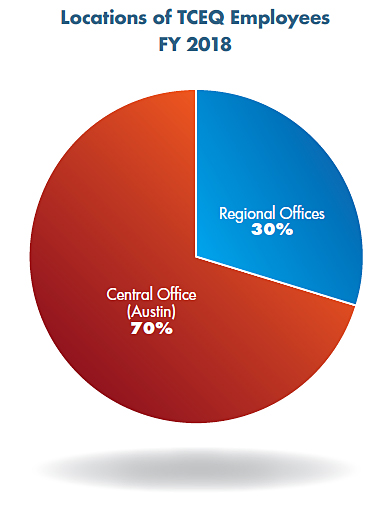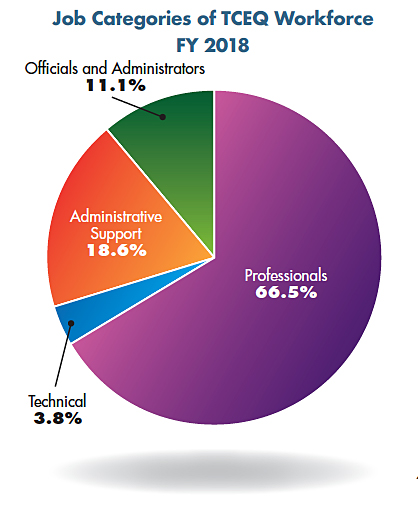Chapter 4: Agency Resources (FY2017-2018)
This chapter outlines the agency’s workforce and financial resources. (Biennial Report to the 85th Legislature, FY2017-FY2018)
This chapter outlines the agency’s workforce and financial resources.
The TCEQ has about 2,700 full-time employees, with more than a quarter working outside of the Austin headquarters. The agency has 16 regional offices, as well as five satellite offices throughout Texas.
These field offices give the TCEQ a statewide presence, enabling its staff to communicate firsthand with municipalities, businesses and industry, and community groups in all quarters of Texas.
The TCEQ’s budgetary needs are based on the demands of state and federal laws concerned with protecting human health and the environment. The operating budget totaled $461.5 million in fiscal 2017 and $374.2 million in fiscal 2018. Most of the budget is supported from revenues collected from fees.
The TCEQ posts its quarterly expenditures online. The data is reported in broad categories, such as, salaries, travel, utilities, and maintenance. The webpage also links to an expenditure database, called “Where the Money Goes,” at the state comptroller’s website. These online postings are in response to the Texas Legislature’s call for greater accountability in state government.
Workforce
Size and Job Categories
The overall size of the TCEQ workforce remains fairly consistent. In fiscal 2017, the agency was authorized to have 2,780.2 full-time-equivalent (FTE) positions, and the average number of FTEs utilized was 2,675.8. In fiscal 2018, the authorized FTEs were 2,794.8; the TCEQ averaged 2,614.7 during that time.
TCEQ staff is composed largely of professionals trained in science, technology, engineering, computer science, and related fields. In fiscal 2018, professionals represented 66.5 percent of the workforce; technical and administrative support staff made up 22.4 percent; and officials and administrators (managers) filled 11.1 percent of positions. These percentages reflect almost no change in the distribution of job categories within the agency from fiscal 2017, with professionals up only 0.3 percent, technical and administrative support staff up 0.6 percent, and officials and administrators (managers) down 0.35 percent.


Equal Employment
The TCEQ’s policy is to afford equal-employment opportunities to all employees and qualified applicants, regardless of race, color, religion, national origin, sex, sexual orientation, age, disability, genetic information, veteran status, or other status protected by law.
The agency is committed to recruiting, selecting, and retaining a multitalented, culturally diverse workforce that is representative of the state’s available labor force. In accordance with the Texas Labor Code, Chapter 21, all employees are trained on equal-employment practices to make them aware of state and federal employment laws and regulations.
With regard to race and ethnicity, the agency’s workforce composition in fiscal 2018 was categorized as 63.2 percent white, 10.6 percent black, 17.8 percent Hispanic, and 8.4 percent other ethnicities (including Asian, Pacific Islander, American Indian, and Alaskan Native). With regard to gender, women continue to be in the majority at the TCEQ: female employees represented 53 percent; males, 47 percent.
Ethnicity and Gender
The Legislature requires each state agency to analyze its workforce by ethnicity and gender. The TCEQ compares its workforce to the state civilian workforce using data provided by the Civil Rights Division of the Texas Workforce Commission. The TWC’s report on equal-employment-opportunity hiring practices, which is published at the beginning of each legislative session, uses data sets based on the percentage of blacks, Hispanics, and females—by job category—within the civilian labor force in Texas.
In fiscal 2018, the TCEQ exceeded the percentage of the available black labor force in the job category of administrative support by 8.8 percent. The agency’s female workforce exceeded the available female labor force in top management (officials and administrators/managers) by 7.5 percent, as well as in administrative support, by 11.1 percent.

Recruitment and Retention
In fiscal 2018, staff turnover was 13.53 percent, 1.7 percent above fiscal 2017. The TCEQ’s turnover continues to fall below the overall average for full- and part-time classified employees at state agencies, significantly due to the effectiveness of the agency’s recruitment and retention programs.
The TCEQ administers multiple hiring programs tailored to meet the agency’s unique hiring needs. As an example, the Engineer Hiring Program is designed for individuals who hold a professional engineering license (PE). Express Hire allows supervisors to extend a conditional offer of employment at recruiting events, and Transitions Hiring expedites hiring and provides a diverse applicant pool for entry-level positions requiring a college degree.
The agency recruits widely, including at colleges and universities throughout the state. And recently it began using recruitment bonuses to attract candidates for positions—offered in remote locations and requiring highly technical skills.
The TCEQ also administers the Mickey Leland Environmental Internship Program. MLEIP offers summer internship opportunities for minorities and female students pursuing environmental, engineering, science-related, and public-administration careers. Intern familiarity with the agency’s mission and working environment often spurs their future interest in full-time employment at the agency.
Retention strategies include employee recognition and administrative-leave awards, wellness programs, flexible schedules, and retention bonuses for staff classified in mission-critical occupations experiencing significant turnover. To retain and deepen employee expertise, the TCEQ offers robust programs. The recently rolled out onboarding program offers new employees planned activities to ensure that they become fully acclimatized to TCEQ programs and personnel.
Another retention tool is the agency’s facilitation of employee movement internally. In addition to the employee’s ability to apply for posted positions, there is the Lateral Transfer Opportunity Program. Lateral transfers facilitate career enhancement, allowing for mastery of other subject matter without impacting classification or pay. As staff look toward leadership and management opportunities, the Leadership and Management Excellence Program offers eligible employees training that promotes the alignment of their leadership and management development with the TCEQ’s organizational goals.
Finances
In fiscal 2017, the agency’s approved operating budget was $461.5 million. Of that, $398.8 million was appropriated from general revenue-dedicated fee revenue, $40.0 million from federal funds, and $10.5 million from general revenue. Other sources provided the remaining $12.2 million.
In fiscal 2018, the approved operating budget totaled $374.2 million. Of that, $311.0 million was appropriated from dedicated fee revenue, $38.0 million from federal funds, and $16.9 million from general revenue. Other sources supplied the remaining $8.2 million.
Pass-through funds accounted for 48 percent of the agency’s operating budget in fiscal 2017 and 34 percent in fiscal 2018. Pass-through funds primarily support grants, remediation, and reimbursements for agency programs. Such programs included the Texas Emissions Reduction Plan (TERP), Clean Rivers, and Municipal Solid Waste Programs; Petroleum Storage Tank and Superfund cleanups; and the since vetoed Low-Income Repair Assistance, Retrofit, and Accelerated Vehicle Retirement Program. The LIRAP veto accounted for the majority of the pass-through funding variance between fiscal 2017 and fiscal 2018
Funds other than those passed through are devoted to day-to-day agency operations. Salaries accounted for 37 percent in fiscal 2017 and 46 percent in fiscal 2018. The remaining operating funds support professional services, supplies, utilities, rent, travel, training, and capital needs.


Fees
The TCEQ collects more than 100 separate fees. The fees listed below each generated revenue of more than $17 million a year:
- Texas Emission Reduction Plan ($231 million in fiscal 2017, $247.1 million in fiscal 2018). TERP funding supports programs vital to implementing the State Implementation Plan. The TERP Account (5071) draws from five fees and surcharges, assessed on the sale, registration and inspection of vehicles. The TCEQ, the authorized manager of the account, handles the management and transfer of funds. The Comptroller of Public Accounts (CPA), the Texas Department of Public Safety, and the Texas Department of Motor Vehicles collect the fees on behalf of the TCEQ.
- Petroleum-Product Delivery Fee ($16 million in fiscal 2017, $17 million in fiscal 2018). The fee is assessed on the bulk delivery of petroleum products. The CPA collects and deposits the fee to the Petroleum Storage Tank Remediation Account (0655).
- Air Emissions Fee ($42 million in fiscal 2017, $36.3 million in fiscal 2018). The fee recovers the costs of developing and administering the Title V Operating Permit Program. Revenue is deposited to the Operating Permit Fees Account (5094).
- Solid-Waste Disposal Fee ($32 million in fiscal 2017, $34 million in fiscal 2018). The fee is assessed on the operators of municipal solid-waste facilities for the disposal of solid waste. Account 0549 receives 66.7 percent of the revenue collected; Account 5000 receives 33.3 percent.
- Motor-Vehicle Safety-Inspection Fee ($44.4 million in fiscal 2017, $45.9 million in fiscal 2018). The fee, assessed per vehicle, is assessed on the sale of state safety-inspection stickers at inspection stations, auto dealers, and other service providers. Revenue is deposited to the Clean Air Account (0151).
- Consolidated Water Quality Fee ($27.8 million in fiscal 2017, $28 million in fiscal 2018). The fee is assessed against each permit, issued under the Texas Water Code, Chapter 26, authorizing the treatment and/or discharge of wastewater. It is calculated based on factors including flow volume and type, traditional pollutants, toxicity, and whether a facility is designated as major or minor. The fee revenue is deposited to Water Resource Management Account 0153.
- Public Health Service Fee ($23.7 million in fiscal 2017, $24.3 million in fiscal 2018). This fee, based on the number of connections, is assessed on owners or operators of public drinking water supply systems. Revenue is deposited to Water Resource Management Account 0153.
- Lead Acid Battery Fee ($21.7 million in fiscal 2017, $22.5 million in fiscal 2018). The fee is assessed on the retail sale of lead acid batteries. A fee of $2.00 is assessed on the purchase of lead acid batteries less than 12 volts—the surcharge on batteries 12 volts and higher is $3.00. The CPA collects and deposits the revenue to the Hazardous and Solid Waste Remediation Account (0550) on behalf of the TCEQ.
Fee Revisions
State legislation passed in 2017 changed the TCEQ’s fees and funding structure as follows:
- Senate Bill 1330 required the TCEQ to deposit the gross receipts surcharge fee used to fund the Low-Level Radioactive Waste Compact Commission to Low-Level Radioactive Waste Fund Account 0088, instead of to General Revenue.
- Senate Bill 1105 abolished Used Oil Recycling Account 0146 and transferred the account’s balance and future revenue to Water Resource Management Account 0153. Fees, penalties, and interest collected on used oil sales were deposited to the-then Used Oil Recycling Account.
- For the 2018-2019 biennium, House Bill 2662 reduced the surcharge of the total contracted rate assessed for the disposal of nonparty compact waste at the compact waste disposal facility located in Andrews County. That reduction was from 20 percent to 10 percent. HB 2662 also halted collecting the 5 percent surcharge assessed on the gross receipts on all compact and federal waste disposed at the compact waste disposal facility for the biennium. After August 2019, the previous assessments will be reinstated automatically.
- HB 2771 required that the $10 fee collected for the processing of an on-site wastewater treatment permit application be used only for on-site septic research grants and administrative costs.
- A veto of Low-Income Repair Assistance, Retrofit, and Accelerated Vehicle Retirement Program funding was followed by participating counties opting out. No additional fee revenue is expected.

